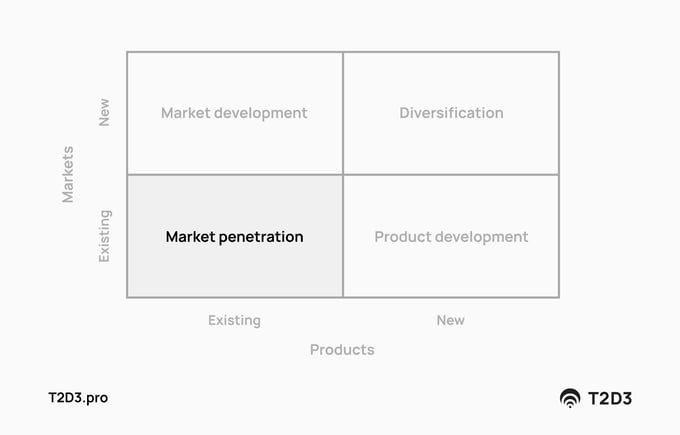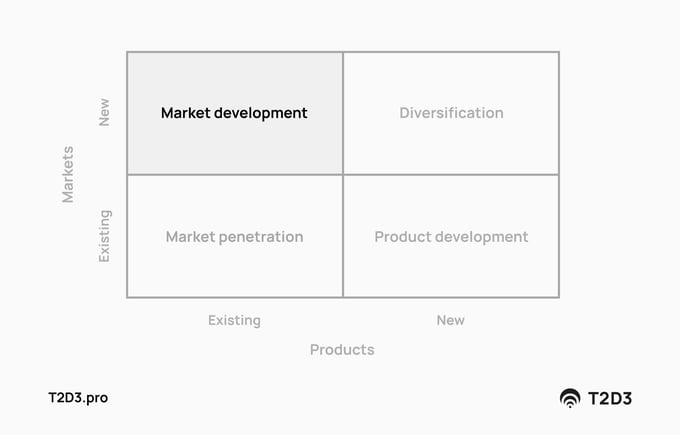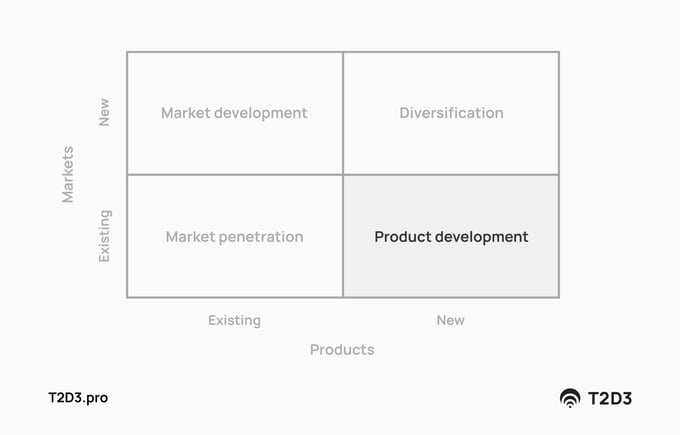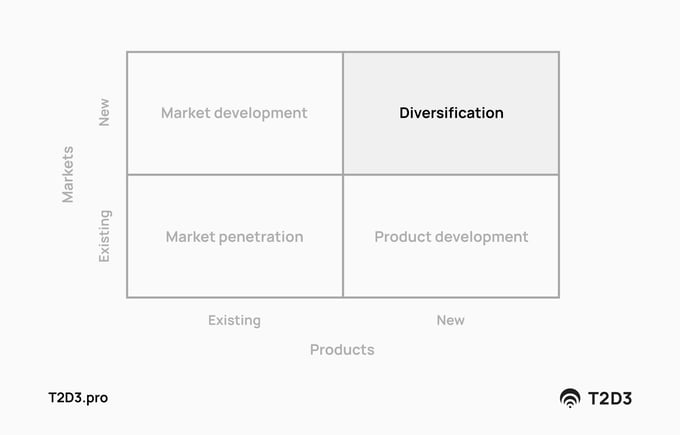If you’re leading a growth planning exercise with your leadership team and unsure of what to include in each quadrant of your Ansoff Matrix, here’s a collection of examples to help you get started.
I’ve broken this article into four parts—one for each quadrant. In each section, I’ve explained the quadrant conceptually with overarching ‘themes’ then provided some specific examples of growth levers you might use to achieve B2B SaaS growth.
Quadrant 1 - Market penetration
Existing product | Existing customers

Quadrant 1 is about patching your funnel leaks and upgrading its component parts. In other words, find more customers that look like your existing customers, and optimize your existing product, sales, marketing, and customer success mix.
This quadrant contains a core growth strategy once you've achieved some form of product-market fit (PMF). For companies under ~$10 million ARR, focusing on market penetration should be your primary growth strategy.
Growth levers in this quadrant should focus on the below:

Themes:
- Improve funnel conversion
- Optimize handoff from marketing to sales
- Increase prices for existing customers
- Create upsell opportunities
- Optimize prices
- Remove bad-fit customers (or find more good-fit)
- Convert existing content or services into products (or marketing assets)
- Create new sales, marketing, or customer success assets
- Find new/better ways to attract more customers like the ones you already have
- Create (or buy) more market share
- Improve the performance of your marketing campaigns
Growth lever examples:
- Create upsell campaigns for highly engaged customers
- Enrich customer data and use findings to refine ICP and pilot an account-based marketing program
- Launch a user referral program
- Collect testimonials and reviews from ICP customers
- Analyze current SERP rankings and optimize page 2/3/4 articles
- Buy market share through an acquisition
- Optimize pricing based on customer data and competitive trends
- Add more variables to pricing to drive up ACV for heavy-usage customers
- Capture existing demand through new PPC campaigns
- Create more detailed documentation to help customers onboard themselves
- Identify common flags that signal a customer is likely to churn and create automation to provide extra support
- Add annual price escalators into all new contracts
- Turn introductory sales team demos into pre-recorded demos for the website to improve inbound MQL quality
- Create a partner program to incentivize referrals
- Recruit and enable partner resellers
- Engage partners in thought leadership content
- Create more documentation to help customers onboard themselves
- Launch onboarding videos to address high-volume customer support issues
- Reduce problem customers (eliminate non-strategic customers)
- Launch a new YouTube channel/podcast/content series/original data research project
- Reduce CAC of existing demand-generation campaigns (PPC, paid search, etc.)
- Build a community of power users (user group)
Quadrant 2 - Market development
Existing product | New customers

Quadrant 2 is all about diversifying your customer acquisition channels.
Complete this quadrant with levers that help you take your current offerings to new customer groups. These tactics are about expanding your beachheads and entering new market segments.
Themes:
- Expand your ICP and personas to adjacent segments
- Explore partnerships to access new markets, complete your product offering, or lower the cost of sales
- Explore new regions, territories or industries
- Test and optimize new demand-generation channels
- Acquire an indirect competitor in an adjacent segment
Growth lever examples:
- Sign on ten pilot customers in the hospitality vertical
- Create new educational content and product marketing materials for medical directors
- Test market-message fit with an account-based marketing campaign for a secondary ICP in healthcare
- Create a new paid content distribution campaign to test acceptance in secondary vertical
- Focus on Europe as a new market (Build customer base in EU)
- White label primary product to attract agencies and consultants
- Close our first ten large ACV-size contracts (ABM campaigns targeted at enterprise prospects)
- List our main product on the HubSpot Marketplace to access growing SMBs
- Run a pilot program with a partner reseller
Quadrant 3 - Product Development
New product | Existing customers

Quadrant 3 is about expanding your offerings to increase revenue. This quadrant often includes product improvements that increase your ARPU (average revenue per unit) or increase the ACV (average contract value) of your current customer base.
Consider ways you can introduce new service offerings or add product capabilities that fit the needs of your current ICP—whether by building or buying them.
Themes:
- Invest in research and development of new features for your existing customer base and prospects who fit your ICP
- License the right to use someone else’s technology
- Buy new capabilities to integrate into your product
- Improve your value proposition through the introduction of new features
Growth lever examples:
- Add machine learning to the product
- Offer setup and configuration services
- Build an integration with HubSpot
- Build pre-populated templates for most common customer use-cases
- Get our main product "Salesforce certified" to become more trustworthy
- Obtain SOC 2 compliance
- Add OCR capabilities to our HR products
- Build a mobile version of our primary product
- Add machine learning to the product as a feature
- Focus development efforts on our enterprise product backlog and create new pricing tier for power users
Quadrant 4 - Diversification
New product | New customers

Quadrant 4 is about diversifying both your product and your market. Product diversification isn't easy, and most companies struggle to pull a market and customer pivot successfully.
Use your marketing insights, competitive analysis, customer feedback, and market indicators to inform your decision to pursue tactics in quadrant 4.
A real-life (and successful) example of product diversification is the shift distilleries made in 2020 from creating alcohol to hand sanitizer in response to the Covid-19 pandemic and shortages on medical and healthcare supplies.
Themes:
- Develop new products for new markets based on a unique capability
Growth lever examples:
- Build integrations with low-end ERPs to attract small-businesses
- Build a XXX Integration and new go-to-market to complement it
- Complete our database schema and sell to app providers
What's next?
Once your leadership team has agreed on a mix of growth levers to use, you should formalize them into a complete go-to-market summary. Then, use the growth levers as the sole source of inspiration for building your team's OKRs.
A framework to help you set marketing OKRs based on the maturity of the function
READ ARTICLE